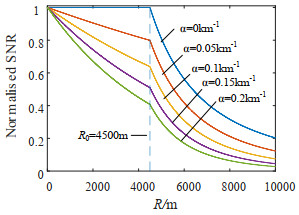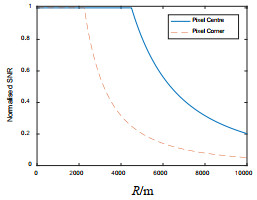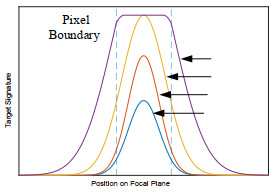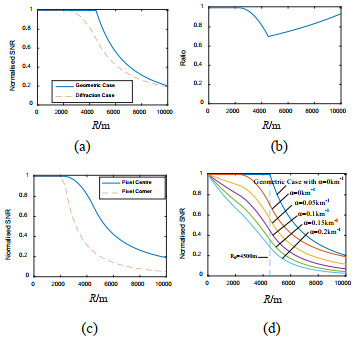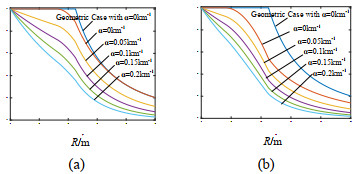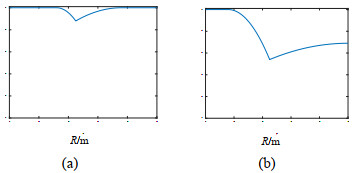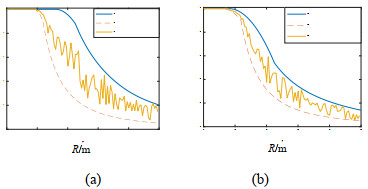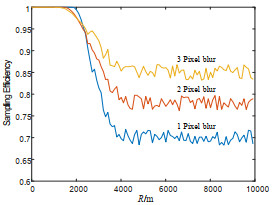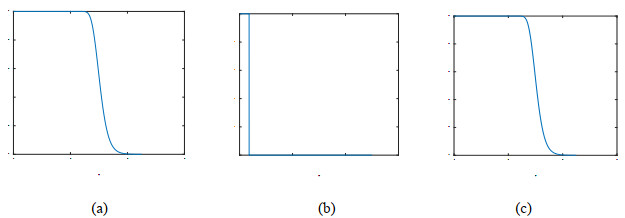Analysis and Modeling of IR Detection Systems for Complex Scenes
-
摘要:
仿真建模在红外探测系统性能设计、试验鉴定或效能推演等领域具有广泛的应用前景。为了满足复杂作战场景下红外探测系统性能仿真建模的迫切需求,在传统红外探测系统几何成像模型的基础上进一步分析了红外探测器阵列结构、采样效率、图像模糊等因素对探测的影响,另外还对复杂作战场景中自然杂波和激光压制以及假目标欺骗等人为干扰对于红外探测性能的影响进行了深入分析,并将这些影响因素引入红外探测系统的性能建模中,建立了一个能够适用于复杂作战场景的红外探测系统性能仿真推演的数学模型并将其集成于仿真推演系统中。仿真推演实例表明,该模型能够在复杂作战场景中逼真模拟红外探测系统的性能特征,对红外探测系统设计、性能评估以及使用效能仿真推演具有应用价值。
Abstract:Modeling and simulation have wide applications in the performance design, test evaluation, and combat simulation of IR detection systems. To meet the need for the performance modeling of IR detection systems in complex combat scenes, the effects of the detector array structure, sampling efficiency, image blur, and other factors on detection were analyzed based on the traditional geometric model, and the effects of clutter and human interference on detection in complex scenarios was analyzed. All these factors were introduced into the performance modeling of the IR detection system, and an IR detection system model that can be applied to complex scenes was established. Simulation examples show that the model can realistically simulate the performance characteristics of IR detection systems in complex combat scenes and has important application value in IR detection system design, performance evaluation, and combat test simulation.
-
Keywords:
- infrared detection /
- simulation and modelling /
- complex scene /
- interference factors
-
0. 引言
红外探测属无源被动探测,具有利于隐蔽、昼夜工作等优点,已成为一种重要的探测手段而广泛应用于各类不同领域,例如红外搜索与跟踪系统、红外对抗系统以及红外制导系统等[1-3]。对于各类红外探测系统,不论是在论证设计阶段的性能估计或方案优化,还是在试验应用阶段的仿真试验或使用效能推演等,都离不开仿真建模。将系统基本结构设计参量与系统综合性能指标有效结合,逼真模拟系统的性能特征[4]。
从仿真建模的角度来看,对于一个红外探测系统通常有两种表示方法:参数模型和图像流模型,也可称为功能级模型和信号级模型[5-7]。在参数模型中,红外探测系统的性能由一组包含目标、背景、大气效应、光学效应以及探测器效应等要素的数学公式或传递函数集来表示,其通过信噪比等参数反映了红外探测系统的平均响应能力。与参数模型不同,图像流模型通过建模生成红外焦平面阵列所成图像以及图像处理算法等细节。参数模型和图像流模型都有各自显著特点,应根据实际需求采用相应的建模方法。例如,参数模型主要适用于系统设计阶段的性能预测和设计优化、试验鉴定阶段的性能评估以及应用阶段的功能性仿真推演等场景,而图像流模型因包含场景图像细节而更适用于红外探测系统图像处理算法及其抗干扰算法的开发和验证[8-10]。
随着红外探测系统等装备试验逐渐从“单装性能试验”向“体系对抗试验”转变,图像流模型受其数据量和计算量的限制显然难以应用于装备体系对抗仿真。而现有参数模型大多仅从几何成像原理对红外探测系统性能进行建模,难以逼真反映包含各类自然和人为干扰的复杂环境下红外探测系统的性能特征。因此,本文在传统红外探测系统参数模型的基础上重点研究了探测器采样效率、衍射效应等系统自身因素的影响,以及红外杂波以及人为干扰等复杂环境的影响,并将其纳入红外探测系统性能仿真建模中,以满足复杂场景下体系对抗仿真试验对于红外探测系统性能建模的迫切需求。
1. 几何成像模型
1.1 焦平面阵列结构影响
传统对于红外探测能力的建模主要包括最小可探测温差(Minimum Detectable Temperature Difference, MDTD)、最小可分辨温差(Minimum Resolvable Temperature Difference, MRTD)和噪声等效功率(Noise Equivalent Power, NEP)等不同类型。文献[11]对这3种方法进行了详细的分析比较,其中MDTD模型主要适用于点目标情形,目标经过大气的衰减后到达系统的能量只要大于探测阈值,系统即可对目标进行探测。MRTD模型适用于扩展目标,其不仅包含了目标辐射特性和探测系统性能,还涵盖了观察者的主观因素。NEP模型主要是考虑噪声因素对探测能力的影响,红外探测系统在对目标进行探测时都会存在噪声的干扰,故此方法可对不同类型目标尤其是在噪声较大情形的探测能力进行估算。在红外探测系统探测目标过程中,目标距离通常由远及近变化,目标在红外探测系统中成像由点目标逐渐变为扩展目标。同时在复杂工作场景中系统信噪比(Signal Noise Ratio, SNR)通常较小,噪声对目标探测的影响较大,因此本文选用NEP模型为基础进行建模。然而,传统NEP模型仅适用于计算均匀背景下点目标的SNR,其没有考虑焦平面阵列(Focal Plane Array, FPA)结构及其复杂背景对成像的影响。因此本文首先对FPA结构影响进行分析。
红外探测系统的探测性能取决于FPA单个像素的响应。首先考虑简单情况,假设焦平面上的图像仅由几何投影所决定,目标图像中心与像素中心一致并忽略衍射和模糊效应。另外为了便于分析,假设每个像素均为边长为d的正方形,并且像素间没有间隙。不同距离处目标图像在FPA上分布如图 1所示。图中,R为目标到红外探测系统的距离。
目标图像大小与距离有关,若MT和MB分别为目标和背景的辐射出射度,目标面积为AT,光学系统焦距为f,像元尺寸为d,一个像素所对应目标面积为AFP=(d/f)2。当AT≤AFP时,即目标为点目标时,FPA上一个像素接收到包括目标和背景的辐照度为:
$$ {E_{\text{T}}} = \frac{{{A_{\text{T}}}{{\text{e}}^{ - \alpha R}}}}{{{\text{π}}{R^2}}}{M_{\text{T}}} + \frac{{({A_{{\text{FP}}}} - {A_{\text{T}}}){{\text{e}}^{ - \alpha R}}}}{{{\text{π}}{R^2}}}{M_{\text{B}}} $$ (1) 式中:α为大气衰减系数。
一个像素上只包含背景的辐照度为:
$$ E_{\mathrm{B}}=\frac{A_{\mathrm{FP}} \mathrm{e}^{-\alpha R}}{\pi R^2} M_{\mathrm{B}} $$ (2) 目标和背景像素之间的功率差为:
$$ \Delta {\phi _T} = ({M_T} - {M_B})\frac{{{A_{\text{T}}}{A_{\text{o}}}}}{{\pi {R^2}}}{\tau _{\text{o}}}{{\text{e}}^{ - \alpha R}} $$ (3) 式中:Ao为光学系统面积;τo为光学系统衰减系数。
将NEP写为噪声等效辐照度(Noise Equivalent Irradiance, NEI)与FPA上一个像素面积Ap乘积的形式,得到点目标情形下的信噪比SNRU为:
$$ SN{R_U} = \frac{{({M_{\text{T}}} - {M_{\text{B}}}){A_{\text{T}}}{A_{\text{o}}}{\tau _{\text{o}}}{{\text{e}}^{ - \alpha R}}}}{{{\text{π NEI}} \cdot {A_{\text{p}}} \cdot {R^2}}} $$ (4) 点目标图像的面积小于或等于一个像素,对于目标距离大于或等于R0。其中,
$$ {R_0} = f\sqrt {\frac{{{A_{\text{T}}}}}{{{A_{\text{p}}}}}} $$ (5) 当AT>AFP时,目标在FPA上成像范围扩展到多个像素上,其由点目标变为扩展目标。而探测所需的SNR仍仅从单个像素获取,式(4)显然是无效的。若目标在焦平面的图像面积为Ai,在旁轴近似中有AT/R2=Ai/f2。那么,在一个像素面积上目标和背景之间的功率差为:
$$ \Delta {\phi _{\text{T}}} = ({M_{\text{T}}} - {M_{\text{B}}})\frac{{{A_{\text{p}}}}}{{4{\text{F}}{{\text{N}}^2}}}{\tau _{\text{o}}}{{\text{e}}^{ - \alpha R}} $$ (6) 式中:FN表示F数。通过式(6)可以得到扩展目标情形下的信噪比SNRR为:
$$ {\text{SN}}{{\text{R}}_{\text{R}}} = \frac{{({M_{\text{T}}} - {M_{\text{B}}}){\tau _{\text{o}}}{{\text{e}}^{ - \alpha R}}}}{{4{\text{NEI}} \cdot {\text{F}}{{\text{N}}^2}}} $$ (7) 从式(7)可以看出,扩展目标的信噪比不再随1/R2变化。虽然在FPA接收的总辐射随1/R2增加而增加,但目标图像面积随着R2增加而增加,接收功率分布在更多的像素上。对于扩展目标的信噪比计算中唯一与目标距离相关的只有大气传输因素中的距离项。
综合式(4)和式(7),用一个通用信噪比函数SNR同时包含点目标和扩展目标,其可以表示为:
$$ {\text{SNR}} = \gamma \frac{{({M_{\text{T}}} - {M_{\text{B}}}){A_{\text{T}}}{A_{\text{o}}}{\tau _{\text{o}}}{{\text{e}}^{ - \alpha R}}}}{{{\text{π NEI}} \cdot {A_{\text{p}}} \cdot {R^2}}} $$ (8) 式中:
$$\left\{ {\begin{array}{*{20}{l}} {\gamma = 1\;\;\;\;\;\;\;\;\;R \ge {R_0}}\\ {\gamma = {{\left( {\frac{R}{{{R_0}}}} \right)}^2}R<{R_0}} \end{array}} \right.$$ (9) 为了直观呈现SNR与目标距离的关系,本文计算了5种不同大气衰减系数下SNR与目标距离的函数曲线,如图 2所示。其中设定红外探测系统的光学孔径直径为90 mm、FN为3、像素尺寸为30 μm。目标为边长为0.5 m的正方形,其在4500 m处所成像的大小刚好等于一个像素,即R0=4500 m。值得注意的是,为了便于比较,这里将最大峰值SNR设为1。
1.2 采样效率影响
忽略大气传输效应,当目标图像大于一个像素面积时,中心像素的最大输出近似为一个恒定值。通过定义采样效率来衡量一个像素收集的功率大小。假设采样效率为ξ,对于点目标,其辐射落在一个像素内,ξ=1。对于扩展目标,当该像素已接收到单个像素可以收集到的最大功率时,ξ=1。在这两个极端状态之间,ξ (R)≤1。
采样效率可写为:
$$ \xi = \frac{{\int {\int_{ - p/2}^{p/2} {T(x, y){\text{d}}x{\text{d}}y} } }}{{\gamma \int {\int_{ - \infty }^{ + \infty } {T(x, y){\text{d}}x{\text{d}}y} } }} $$ (10) 式中:T(x, y)为目标在焦平面上的空间分布。
现考虑采样效率的影响,式(1)中一个像素接收到包括目标和背景的辐照度修改为:
$$ {E_{\text{T}}} = \frac{{\xi {A_{\text{T}}}{{\text{e}}^{ - \alpha R}}}}{{{\text{π}}{R^2}}}{M_{\text{T}}} + \frac{{({A_{{\text{FP}}}} - \xi {A_{\text{T}}}){{\text{e}}^{ - \alpha R}}}}{{{\text{π}}{R^2}}}{M_{\text{B}}} $$ (11) 对于不包含目标辐射的相邻像素,其辐照度仍为式(3)不变。目标和背景像素的功率差为:
$$ \Delta {\phi _{\text{T}}} = \xi ({M_{\text{T}}} - {M_{\text{B}}})\frac{{{A_{\text{T}}}{A_{\text{o}}}}}{{{\text{π}}{R^2}}}{\tau _{\text{o}}}{{\text{e}}^{ - \alpha R}} $$ (12) 假设考虑采样效率影响的信噪比为SNRS,根据式(12),可用信噪比重写式(10)为:
$$ \xi = \frac{{{\text{SN}}{{\text{R}}_{\text{S}}}}}{{{\text{SNR}}}} $$ (13) 根据式(8)和式(13)可得:
$$ {\text{SN}}{{\text{R}}_{\text{S}}} = \xi \cdot \gamma \frac{{({M_{\text{T}}} - {M_{\text{B}}}){A_{\text{T}}}{A_{\text{o}}}{\tau _{\text{o}}}{{\text{e}}^{ - \alpha R}}}}{{{\text{π NEI}} \cdot {A_{\text{p}}} \cdot {R^2}}} $$ (14) 对于目标图像中心与像素中心一致的几何成像情况,均满足ξ=1。因此,这对应于最有效的成像条件。在实践中,成像系统很难达到这样的性能,通常是ξ<1,这将在下面进行分析。
1.3 目标偏移影响
一般来说,目标图像中心与像素中心之间并没有预先确定的关系。这可通过在公式(10)中增加一个偏移量进行表征:
$$ \xi = \frac{{\int {\int_{ - p/2 + o}^{p/2 + o} {T(x, y){\text{d}}x{\text{d}}y} } }}{{\gamma \int {\int_{ - \infty }^{ + \infty } {T(x, y){\text{d}}x{\text{d}}y} } }} $$ (15) 式中:o为像素中心相对于目标图像中心的偏移量,0≤o≤d/2且在x和y方向上相互独立。
式(15)可以通过分析目标图像位于像素角落,使其功率平均分布在4个相邻像素之间的特殊情况来进行检验。当大气衰减系数α=0 km-1时,目标中心位于像素中心和位于像素边角的SNR对比如图 3所示。
图 3中,当R≥R0、γ=1、ξ=1/4时,SNRS=SNR/4。当R0/2<R≤R0时,目标图像被扩展,但没有单个像素接收到最大功率,因此γ<1,SNRS<SNR。当目标图像大小增加到2个像素时,则ξ=1以及SNRS=SNR。
当目标中心位于像素中心时,出现最大信噪比,而最小值对应于目标中心位于像素边角的情况,二者形成了SNR的边界,SNR值将在该边界内随目标距离的增加而减小。
2. 图像模糊影响
2.1 衍射受限PSF
第1章中仅是基于几何成像考虑,而在现实中还需考虑红外探测系统在焦平面上形成的图像模糊效应,其中影响最大的为衍射效应。目标距离比较远时,一个点目标由于衍射效应所成像为点扩散函数(Point Spread Function, PSF),即:
$$ {\text{PSF}}(r) = I(0){\left\{ {\frac{{2{J_1}[{\text{π}}r/(\lambda \cdot {\text{FN}})]}}{{{\text{π}}r/(\lambda \cdot {\text{FN}})}}} \right\}^2} $$ (16) 式中:I(0)为焦点处的光强;J1()为一阶贝塞尔函数;r为衍射圆半径;λ为波长。对于扩展目标,其图像可通过目标几何图像与PSF卷积计算得到,即:
$$ {I_i}(x, y) = {I_0}(x, y) \otimes {\text{PSF}}(x, y) $$ (17) 式中:Ii为FPA上的图像;I0为场景的几何学图像。
图像质量通常根据调制传递函数(MTF)进行分析。一般来说,一个光学系统的整体MTF是多个单调递减MTF函数(衍射、像差、探测器、电子学效应等)的乘积,中心极限定理表明该乘积趋向于高斯函数[12]。因此假设系统MTF具有高斯分布,标准化的PSF可以写成:
$$ {\text{PSF}}(x, y) = \frac{1}{{2{\text{π}}{\sigma ^2}}}{{\text{e}}^{ - \frac{{{x^2} + {y^2}}}{{2{\sigma ^2}}}}} $$ (18) 假定目标图像以某一个像素为中心,图 4显示了目标图像大小从亚像素逐渐扩展到大于一个像素时,由PSF引起的图像模糊情况。其中为了使图像模糊直径接近像素尺寸,本文将PSF高斯分布的标准差设置为p/6。值得注意的是,即使目标图像大小为1.5倍像素面积,中心像素也没有接收到最大功率。
对于目标图像位于某个像素中心的情况,可以通过与PSF进行卷积运算,在采样效率中引入图像模糊,式(10)变为:
$$ \xi = \frac{{\int {\int_{ - p/2}^{p/2} {T(x, y) \otimes {\text{PSF}}(x, y){\text{d}}x{\text{d}}y} } }}{{\gamma \int {\int_{ - \infty }^{ + \infty } {T(x, y){\text{d}}x{\text{d}}y} } }} $$ (19) 根据式(19)得到的信噪比如图 5(a)所示,考虑衍射效应前后SNR之比如图 5(b)所示。该曲线表明了相对于几何成像的情况,光学模糊对于信噪比的降低程度。
![]() 图 5 衍射受限系统的SNR:(a)几何成像条件和衍射条件SNR;(b)几何成像条件和衍射条件SNR之比;(c)图像中心位于像素中心与像素边角的SNR;(d)不同大气衰减下的SNRFigure 5. SNR as a function of range for a diffraction-limited system. (a)geometric and diffraction SNR; (b)Ratio of diffraction to geometric; (c) pixel centre and corner SNR; (d) SNR with atmospheric attenuation
图 5 衍射受限系统的SNR:(a)几何成像条件和衍射条件SNR;(b)几何成像条件和衍射条件SNR之比;(c)图像中心位于像素中心与像素边角的SNR;(d)不同大气衰减下的SNRFigure 5. SNR as a function of range for a diffraction-limited system. (a)geometric and diffraction SNR; (b)Ratio of diffraction to geometric; (c) pixel centre and corner SNR; (d) SNR with atmospheric attenuation另外,还可以通过将PSF卷积引入式(19)来考虑位置偏移的影响,从而给出一个通用的采样效率表达式:
$$ \xi = \frac{{\int {\int_{ - p/2 + o}^{p/2 + o} {T(x, y) \otimes {\text{PSF}}(x, y){\text{d}}x{\text{d}}y} } }}{{\gamma \int {\int_{ - \infty }^{ + \infty } {T(x, y){\text{d}}x{\text{d}}y} } }} $$ (20) 利用信噪比中式(20)的采样效率,分别计算了目标位于像素中心和像素角上的信噪比变化情况,如图 5(c)所示。为了完整起见,还展示了大气衰减的情况,如图 5(d)所示。
2.2 F数影响
上述分析是基于系统FN=3,此时PSF的直径(36.6 μm)与像素尺寸(30 μm)相似。为了研究F数对SNR的影响,本节将分析研究FN=5(PSF的直径为61 μm,大约是像素尺寸的2倍)以及FN=1.2(PSF的直径为14.6 μm,大约是像素尺寸的一半)的效果。
假设目标中心与像素中心一致,计算不同F数的SNR如图 6所示。在图 6(a)中,光学系统口径较大(FN=1.2),PSF直径较小,SNR曲线接近于只考虑几何成像的情况。图 6(b)中,光学系统口径较小(FN=5),由于PSF直径较大,SNR曲线显著降低,这也可以从图 7中给出的比率图中看出。
同样考虑目标图像中心偏离像素中心的情况,分别计算目标图像中心位于像素中心和位于像素边角两种边界情况,以及随机位置条件下SNR值如图 8所示。
从图 8中可以看出,对于FN=1.2、FN=5.0以及图 3中FN=3.0,信噪比上下边界之间的间隔随着FN的增加而减小。这是由于图像PSF直径随着FN的增加而增加,这导致在像素中心和边缘采样的差异降低。
2.3 像差影响
现实中大多数光学系统不是衍射受限系统,而受到各种像差和其他系统退化的影响,包括由于视线运动而造成的散焦和模糊,这些影响反映在PSF标准差的增大上。随着模糊量增加,PSF峰值减少,但对偏移误差的敏感度降低,如图 7所示。图 9进一步说明了这一点,图中分别对单像素模糊σ=d/6、两倍像素模糊σ=d/3以及三倍像素模糊σ=d/2三种条件下采样效率随时间的变化情况进行了100次蒙特卡洛仿真。
3. 场景干扰影响
前文对于红外探测性能分析是假设目标处于单一均匀背景下,其探测性能主要由目标背景对比度和探测器自身决定。然而,在许多应用尤其是战场环境下,红外探测场景中存在着大量自然和人为干扰,这些干扰将对红外探测系统的探测能力产生巨大影响。
3.1 自然杂波影响
自然环境中地物、云层以及海面的背景存在着较大的杂波干扰,大大降低了红外探测系统的探测能力[13-14]。当前对于自然杂波的评价指标主要采用信杂比(Signal Clutter Ratio, SCR)等形式,不过SCR仅考虑了信号和杂波之比。为了将信号、杂波和噪声共同引入红外探测能力模型中,本文将杂波可看作是一种类似噪声的退化,并参照NEI定义了杂波等效辐照度(Clutter Equivalent Irradiance, CEI),即信号与杂波比为1时输入信号每单位面积的功率。将式(14)给出采样后的信噪比修改为信号噪声杂波比,即:
$$ {\text{SNCR}} = \xi \cdot \gamma \cdot \frac{{({M_{\text{T}}} - {M_{\text{B}}}){A_{\text{T}}}{A_{\text{o}}}{\tau _{\text{o}}}{{\text{e}}^{ - \alpha R}}}}{{{\text{π}}{R^2}{A_{\text{p}}}\sqrt {{\text{NE}}{{\text{I}}^2} + {\text{CE}}{{\text{I}}^2}} }} $$ (21) 值得注意的是,由于CEI取决于目标和杂波的相对结构特征,其不仅与探测距离相关还与目标背景的空间分布和纹理特征相关。因此可以对不同距离下的杂波特征进行二维功率谱密度建模,例如高斯-马尔科夫或巴特沃斯模型等。也可以实际采集或者仿真生成红外探测系统在不同目标距离下输出的典型的图像,然后对该图像进行处理。通过PSD建模仿真或图像处理计算得到不同距离对应的CEI值,创建数据查找表。
3.2 人为干扰影响
红外成像系统在军事应用中往往会受到各种各样的人为干扰,例如激光干扰、烟幕遮蔽或假目标等。从作用机理上可将这些干扰归纳为目标迷失式干扰和假目标欺骗式干扰两大类。
目标迷失式干扰主要包括烟幕遮蔽、爆炸强光和激光致盲等,其共性是在一定条件下使红外探测系统失去目标。在信号迷失干扰方式下,目标红外辐射能量在传输过程中急剧衰减或被更强信号覆盖,红外探测系统所接收到的目标信号辐射极其微弱甚至为零。假设衰减系数为τj,信号噪声杂波比可修改为:
$$ {\text{SNC}}{{\text{R}}_{\text{G}}} = {\tau _{\text{j}}}\gamma {\text{SNCR}} $$ (22) 目标迷失式干扰衰减系数τj∈[0, 1],可根据不同干扰类型以及干扰施放时机等因素进行设置。例如,在开始干扰时,红外探测系统收到的有效信号为零,τj=0;干扰结束后,红外探测系统恢复正常工作,τj=1;干扰过程中可根据干扰设置情况调整τj的值。
假目标欺骗式干扰利用假目标改变战场环境状态,引导红外探测系统跟踪假目标,降低真实目标的探测概率,从而达到保护真实目标的作用。假设无假目标干扰时目标探测概率为Pd,基于信噪比可计算目标探测概率为[15]:
$$ {P_{\text{d}}} = \frac{1}{2}\left\{ {1 + {\text{erf}}\left[ {\frac{{({\text{SNC}}R - {\text{SNC}}{R_0})}}{{\sqrt 2 }}} \right]} \right\} $$ (23) 式中:erf为误差函数;SNCR0为目标探测所需的最小SNCR值。
施加假目标干扰后红外探测系统对于目标的探测概率Pjd为:
$$ {P_{{\text{jd}}}} = k \cdot {P_{\text{d}}} $$ (24) 式中:k∈[0.5, 1],其取值大小与假目标的逼真度相关。理想情况下假目标与真目标完全一致而无法辨别,此时k=0.5。
4. 应用实例
在某光电对抗仿真推演系统中,利用本文所述红外探测模型模拟某机载红外侦察系统对地面草地背景中某一目标侦察探测过程进行仿真推演。在探测过程中地面目标可对该机载红外侦察系统采取激光压制和假目标欺骗等手段干扰其侦察。模型主要参数设置如表 1所示,仿真结果如图 10所示。
表 1 仿真模型参数Table 1. Parameters of the simulation modelParameters Values Target area/m2 12 Average target radiance/(W/Sr) 120 Average background radiance/(W/Sr) 8 α 0.05 τj 0 k 0.5 SNCR0 10 FN 1.5 Aperture diameter/cm 3 τo 0.9 Pixel size/μm 15 NEI/(pW/cm2) 0.47 Band/μm 8~10 在无人为干扰场景中,机载红外侦察系统对于该目标在不同距离处的探测概率变化如图 10(a)所示,其中当探测概率为98%时,机载红外侦察系统对于目标的探测距离为26.42 km,这与系统设计指标基本一致。在地面目标施放激光压制干扰场景中,干扰开始时,由于目标被激光光斑遮蔽,探测概率为0,当在距离350 m处干扰停止,探测概率为1,如图 10(b)所示。在地面目标施放假目标干扰场景中,施放假目标干扰时,由于无法分辨真假目标,探测概率最大为0.5,如图 10(c)所示。仿真结果表明本文所述红外探测模型可以有效模拟某机载红外侦察系统在不同复杂场景中性能特征,仿真结果与装备实际性能基本一致。
5. 总结
建模和仿真已经在红外探测系统的设计、开发、试验和使用等全生命周期中得到了广泛应用。本文针对复杂工作场景下仿真试验、使用效能推演对于红外探测系统性能建模的迫切需求,研究了复杂场景红外探测系统性能建模方法。在传统几何成像模型的基础上分析了探测器采样效率、图像模糊的影响,以及复杂场景中红外杂波以及人为干扰的影响,并将它们纳入红外探测系统性能仿真建模中。该方法对于红外探测系统性能设计、评估以及仿真推演具有一定应用价值。本文只是初步研究了复杂场景中红外探测系统的建模方法,对于场景中各种自然和人为干扰的分析建模还可以在此基础上展开进一步研究。
-
图 5 衍射受限系统的SNR:(a)几何成像条件和衍射条件SNR;(b)几何成像条件和衍射条件SNR之比;(c)图像中心位于像素中心与像素边角的SNR;(d)不同大气衰减下的SNR
Figure 5. SNR as a function of range for a diffraction-limited system. (a)geometric and diffraction SNR; (b)Ratio of diffraction to geometric; (c) pixel centre and corner SNR; (d) SNR with atmospheric attenuation
表 1 仿真模型参数
Table 1 Parameters of the simulation model
Parameters Values Target area/m2 12 Average target radiance/(W/Sr) 120 Average background radiance/(W/Sr) 8 α 0.05 τj 0 k 0.5 SNCR0 10 FN 1.5 Aperture diameter/cm 3 τo 0.9 Pixel size/μm 15 NEI/(pW/cm2) 0.47 Band/μm 8~10 -
[1] 马金龙, 马立元, 方丹. 仿真环境下导弹制导控制系统抗干扰性能测试方法[J]. 战术导弹技术, 2020, 31(3): 93-97. MA Jinlong, MA Liyuan, FANG Dan. Test scheme of anti-interference performance of missile guidance and control system in simulation environment[J]. Tactical Missile Technology, 2020, 31(3): 93-97.
[2] 白杨, 张成, 王博宇, 等. 机载末端红外对抗作战效能仿真研究[J]. 红外与激光工程, 2022, 51(11): 141-150. BAI Yang, ZHANG Cheng, WANG Boyu, et al. Simulation of airborne terminal infrared countermeasure operational effectiveness[J]. Infrared and Laser Engineering, 2022, 51(11): 141-150.
[3] 王霞, 白江辉, 金伟其, 等. 红外成像系统动态性能模型进展研究[J]. 红外技术, 2016, 38(12): 997-1004. DOI: 10.11846/j.issn.1001_8891.201612001 WANG Xia, BAI Jianghui, JIN Weiqi, et al. Development and research of infrared imaging system dynamic performance model[J]. Infrared Technology, 2016, 38(12): 997-1004. DOI: 10.11846/j.issn.1001_8891.201612001
[4] 曹淑艳, 唐善军, 范晋祥, 等. 红外探测系统建模仿真: 方法, 应用与问题[J]. 制导与引信, 2017, 38(1): 5-14. CAO Shuyan, TANG Shanjun, FAN Jingxiang, et al. Model and simulation for infrared detection system: approaches, applications and issues[J]. Guidance & Fuze, 2017, 38(1): 5-14.
[5] 王楚越, 杨利峰, 何道刚. 地面点源中波红外探测建模与验证研究[J]. 红外技术, 2023, 45(4): 357-363. http://hwjs.nvir.cn/article/id/cc40dae2-7c8e-435c-9a41-563ced9823c2 WANG Chuyue, YANG Lifeng, HE Daogang. Modeling and verification of ground point source for mid-wave infrared detection[J]. Infrared Technology, 2023, 45(4): 357-363. http://hwjs.nvir.cn/article/id/cc40dae2-7c8e-435c-9a41-563ced9823c2
[6] 徐振亚, 付奎生, 祁鸣, 等. 一种用于发射后截获的红外导引头探测距离估算方法[J]. 红外技术, 2020, 42(11): 1095-1102. http://hwjs.nvir.cn/article/id/dee58fea-97ff-474b-9816-c04a5c62dc81 XU Zhenya, FU Kuisheng, QI Ming, et al. Estimation method of infrared seeker detection range used for lock-on-after-launch[J]. Infrared Technology, 2020, 42(11): 1095-1102. http://hwjs.nvir.cn/article/id/dee58fea-97ff-474b-9816-c04a5c62dc81
[7] Duncan L Hickman. Target detection: the transition from unresolved to extended targets[C]//Proc of SPIE, 2021, 11866: 118660F.
[8] 袁磊, 王毕艺, 罗超, 等. 红外探测系统的激光辐照热效应仿真分析[J]. 强激光与粒子束, 2023, 35(2): 16-22. YUAN Lei, WANG Biyi, LUO Chao, et al. Simulation analysis of thermal effect of laser irradiation in infrared detection system[J]. High Power Laser and Particle Beams, 2023, 35(2): 16-22.
[9] 吴立民, 刘雨晨, 杨坤, 等. 复杂环境下弱信号红外探测系统灵敏度需求及实现方法研究[J]. 激光与红外, 2019, 49(4): 447-453. DOI: 10.3969/j.issn.1001-5078.2019.04.010 WU Limin, LIU Yuchen, YANG Kun, et al. Research on sensitivity requirement and implement method of weak signal infrared detecting system during complicated environment[J]. Laser & Infrared, 2019, 49(4): 447-453. DOI: 10.3969/j.issn.1001-5078.2019.04.010
[10] 郭冰涛, 韩琪, 惠进, 等. 基于识别距离的红外成像仿真验证方法[J]. 应用光学, 2022, 43(4): 719-725. GUO Bingtao, HAN Qi, HUI Jin, et al. Validation method of infrared imaging simulation based on recognition range[J]. Journal of Applied Optics, 2022, 43(4): 719-725.
[11] 刘明奇, 王思远, 何玉青, 等. 采用多种红外视距模型的子弹辐射探测系统作用距离分析[J]. 中国光学, 2015, 8(4): 636-643. LIU Mingqi, WANG Siyuan, HE Yuqing, et al. Bullet radiation detection range analysis based on multiple infrared visual range prediction models[J]. Chinese Optics, 2015, 8(4): 636-643.
[12] 孙新德, 薄树奎, 李琳琳. 基于背景估计的红外图像杂波抑制方法研究[J]. 激光与红外, 2011, 41(5): 586-590. SUN Xinde, BO Shukui, LI Linlin. Study of infrared image clutter suppression based on background estimation[J]. Laser & Infrared, 2011, 41(5): 586-590.
[13] 童锡良, 周峰. 针对点目标探测的背景杂波量化改进方法[J]. 红外技术, 2018, 40(4): 346-354. http://hwjs.nvir.cn/article/id/hwjs201804008 TONG Xiliang, ZHOU Feng. Improved clutter quantification method for point target detection[J]. Infrared Technology, 2018, 40(4): 346-354. http://hwjs.nvir.cn/article/id/hwjs201804008
[14] 苗锡奎, 张岩岫, 张恒伟, 等. 基于方向选择性机制的图像背景杂波建模方法[J]. 红外与激光工程, 2022, 51(6): 471-481. MIAO Xikui, ZHANG Yanxiu, ZHANG Hengwei, et al. Image background clutter modeling method based on directional selectivity mechanism[J]. Infrared and Laser Engineering, 2022, 51(6): 471-481.
[15] 赵丽, 杨国庆, 李周, 等. 红外系统点目标作用距离计算方法分析与实例[J]. 红外技术, 2022, 44(12): 1273-1277. http://hwjs.nvir.cn/article/id/2fd4abf4-f871-45f5-b54a-629d4b538cbc ZHAO Li, YANG Guoqing, LI Zhou, et al. Analysis and example of operating range calculation method for point target in infrared system[J]. Infrared Technology, 2022, 44(12): 1273-1277. http://hwjs.nvir.cn/article/id/2fd4abf4-f871-45f5-b54a-629d4b538cbc



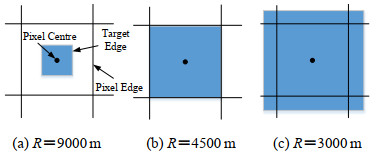
 下载:
下载:
